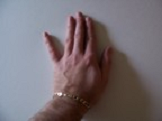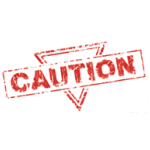In my post Here’s a Quick Way to Understand the Major Scale on Guitar, we looked at how major scales are put together. Today we are going to look at a quick way to play the major scale in every key. To do this we need to first look at a moveable major scale fingering.
Moveable scales are as their name implies—moveable. This means that you can take one scale shape and move it up and down the neck of the guitar to produce any desired scale. In other words, once you learn one of the moveable shapes for a major scale, you just have to move it up or down to produce 11 different major scales.
Here is how it works. The black notes in each scale form represent the root notes. The root note indicates the letter-name of the scale.
If we move the following 6th root major scale form so that the first finger is on the 8th fret, you will have a C major scale.
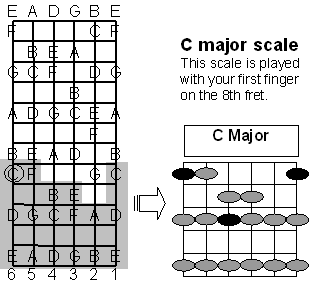
Tip: Notice that there are three root notes in the above scale form. For this fingering, we are only concerned with the root note on the sixth string. All you have to do is position the scale so that the root note is on the appropriate fret. The other root notes found in the scale form will automatically match up.
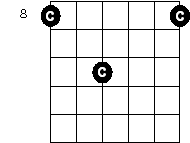
Now move this same scale shape so that the sixth root is on the first fret. Since the root note is on the note F, we now have an F major scale.
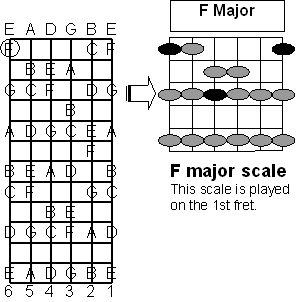
See how simple that is?
This one scale form can be moved up or down the fretboard to produce any major scale that you want.
This is the big thing that is missing from most guitar scale books.
Most guitar players flip through a guitar scale book and think that there is no way that they will ever learn all of those scales.
But here’s the thing: Most scale books will show the same scale form on different pages as if it was a different scale form.
In other words, the major scale form that you were just shown would be found in a typical scale book on one page as F major. Then the next page would show the same scale form on the second fret and call it F# major or Gb major. Then the next page will show the exact same fingering on the third fret and call it G major. The problem is that most of the scale books never explain that it’s just one shape moved up and down the fretboard! This of course leads to needless confusion.
Now there are lots of other ways of play major scales. To get good on guitar and create your own guitar solos, you will want to master these fingerings.
But guess what?
These other scale forms can be played as moveable fingerings as well. So the best way to learn to play any type of scale, whether it be major, minor, harmonic minor, Dorian, Phrygian, etc, is to learn the appropriate set of master fingerings and then simply move the fingerings up or down the fretboard to produce any scale that you want. It’s that simple.
If you are a beginner or intermediate guitar player and want to quickly learn these “master scale fingerings” check out–> Guitar Essentials: Scale Master Expanded Edition. If you are an intermediate or advancing guitarist check out -> The World of Scales: A Compendium of Scales for the Modern Guitar Player.

